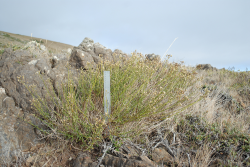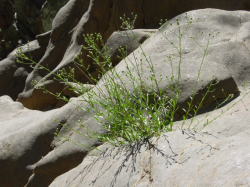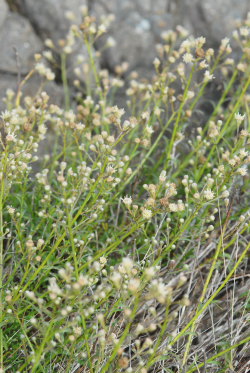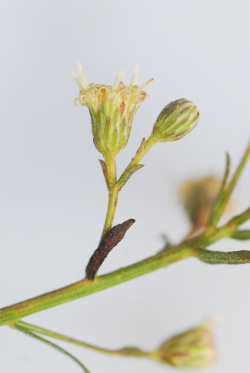
endangered

San Simeon baccharis, near Arroyo de la Cruz, 11 Aug 2011. Photograph © Chris Winchell.

San Simeon baccharis, Fort Hunter Liggett, 7 July 2004. Photograph © Laura Eliassen.

San Simeon baccharis, stems and inflorescences, near Arroyo de la Cruz, 11 Aug 2011. Photograph © Chris Winchell.

San Simeon baccharis, close-up of inflorescence, near Arroyo de la Cruz, 11 Aug 2011. Photograph © Chris Winchell.



This fact sheet was prepared by Dylan Neubauer & Dean W. Taylor under award NA04N0S4200074 from the National Oceanic and Atmospheric Administration (NOAA), U.S. Department of Commerce (DOC). The statements, findings, conclusions, and recommendations are those of the authors and do not necessarily reflect the views of the NOAA or the DOC.
© Copyright 2006, Elkhorn Slough Coastal Training Program
Last updated: Mar 16, 2017 11:56
Common Names - San Simeon baccharis, smooth baccharis
Family - Asteraceae (Sunflower Family)
State Status - none
Federal Status - none
Habitat and Associates
In Monterey Co., San Simeon baccharis occurs in a creek gorge in crevices in very hard, gray, bleached rock (see photo), or on cliff faces of reddish serpentinite on n- and ne-facing slopes, in shade or part sun, with Eriogonum fasciculatum and Quercus durata. In San Luis Obispo Co., San Simeon baccharis occurs in a variety of habitats including the ecotone between coastal scrub and coastal prairie and occasionally in coastal scrub with Salvia mellifera, Baccharis pilularis subsp. consanguinea, and Diplacus aurantiacus; in riparian woodland or willow thickets and in shrub-dominated floodplains; on dry, shady, rocky slopes; and on steep slopes in dwarf chaparral with Ceanothus maritimus (Keil & McLeod 1987, CNDDB 2017). 50–480 m.
Key Characteristics
Perennial, deciduous, dioecious shrub or subshrub, < 80 cm tall; stem erect, slender, ± glabrous (with only the youngest parts puberulent), glandular; leaf sessile, 8–35 mm long, linear to narrowly oblanceolate, base wedge-shaped, tip obtuse, entire to minutely dentate with closely spaced sharp teeth, main veins generally 1, occasionally 3, faces not sticky; heads in compact panicle-like or flat-topped clusters; involucre bell-shaped; phyllaries 2–6 mm long, lance-linear, hairy, glandular, tips acute to acuminate; dioecious; staminate flowers 19–26; pistillate flowers 20–30; cypselae hairy, ribs 5, pappus 7–8.5 mm long (Bogler 2017).
San Simeon baccharis differs from Plummer’s baccharis (B. p. subsp. plummerae) (with California Rare Plant Rank 4.3) in its ± glabrous stem, leaf shape, and number of leaf veins (Sundberg & Bogler 2006, CNPS 2012, Bogler 2017).
Flowering Period
June–November
Global Distribution
Endemic to central coastal CA in sw Monterey Co. in the southern Santa Lucia Mountains on the Hunter Liggett Military Base and in nw San Luis Obispo Co. in the Arroyo de la Cruz/Arroyo de los Chinos and San Simeon Creek region.
Reference Population
None
Taxonomy
Baccharis plummerae was described in 1880 by Asa Gray from a specimen collected “in the mountains near Sta. Barbara.” It was named for Sarah Plummer (= Sarah Lemmon), its discoverer, “an ardent botanist, whose name it is a pleasure to commemorate.” In his 1970 Vascular Plants of San Luis Obispo County, Robert F. Hoover described San Simeon baccharis from collections of male and female plants (7756 & 7757) he obtained at the “forks of San Simeon Creek.” He remarked on the shrub’s distinctiveness, adding, however, that it did “not seem to different enough to rank as a species.”
Conservation and Threats
Though specific threats to this taxon are unknown, in general, small populations are vulnerable to random, stochastic events (USDA 2005) and climate change. Dioecious species, like this one, are even more vulnerable as the loss of one sex prohibits successful reproduction. This issue is essential to any future monitoring efforts (Wilken, pers. comm. 2017).
Limited to six known occurrences: one in Monterey Co. and five in San Luis Obispo Co. The single Monterey Co. occurrence (see photograph) is on the Hunter-Liggett Military Base and, as of 1996, comprised ca. 20 individuals. Due to difficulties involved in surveying the steep terrain, it is likely that population numbers are higher. The area’s remoteness precludes most threats (CNDDB 2017). Ca. 500–1000 acres of suitable habitat exists on the nearby Los Padres National Forest, and there is a “moderately high probability” that the species also occurs there (USDA 2005). Surveys are needed.
The five San Luis Obispo Co. occurrences are on the private Hearst Ranch, and four fall within the “Arroyo de la Cruz Endemic Area” (Keil & McLeod 1989), which is considered to be a biodiversity hotspot within the County (Haydu 2012). There San Simeon baccharis shares habitat with several other local endemics—all of which are of conservation concern (Keil & McLeod 1989). Occurrences in this area range from Arroyo de los Chinos south to Arroyo del Oso. Except for the westernmost occurrence along Highway 1, the three more inland occurrences have not been observed since the 1980s, when at least two of them were known to support many individuals (CNDDB 2017). The southernmost occurrence, near San Simeon Creek, is based on the type locality and has not been observed since 1949 (CNDDB 2017).
In 2005, a conservation easement was put into place for Hearst Ranch, which protects the land in perpetuity. Still a working cattle ranch, Hearst Ranch has been subject to grazing for more than a century.
References
Bogler, D. 2017. Baccharis plummerae subsp. glabrata, in Jepson Flora Project (eds.) Jepson eFlora. http://ucjeps.berkeley.edu/cgi-bin/get_IJM.pl?tid=49414 [acc. 4 Jan 2017].
Buchmann, S., L. D. Adams, A. D. Howell, and M. Weiss. 2010. A study of insect pollinators associated with DoD TER-S flowering plants, including identification of habitat types where they co-occur by military installation in the Western United States. Legacy Resource Management Program, Arlington, VA. http://oai.dtic.mil/oai/oai?verb=getRecord&metadataPrefix=html&identifier=ADA534396 [acc. 4 Jan 2017].
California Native Plant Society (CNPS), Rare Plant Program. 2012. Baccharis plummerae ssp. glabrata. Inventory of Rare and Endangered Plants (online edition, v8-02). California Native Plant Society, Sacramento, CA. http://www.rareplants.cnps.org/detail/1586.html [acc. 7 Feb 2017].
California Natural Diversity Database (CNDDB). 2017. [Internet]. California Department of Fish and Wildlife [acc. 7 Feb 2017].
Gray, A. 1880. Proceedings of the American Academy of Arts and Sciences 15:48.
Haydu, K. 2012. Mapping plant biodiversity hotspots at the county scale: a new tool for establishing resource conservation strategies. Thesis, California Polytechnic State University, San Luis Obispo. http://digitalcommons.calpoly.edu/cgi/viewcontent.cgi?article=1792&context=theses [acc. 4 Jan 2017].
Hoover, R. F. 1970. Vascular plants of San Luis Obispo County. University of California Press, Berkeley and Los Angeles, CA.
Keil, D. and M. McLeod. 1989. Rare plants in the Arroyo de la Cruz Endemic Area, San Luis Obispo County, California. In: Conservation and management of rare and endangered plants: proceedings from a conference of the California Native Plant Society, T. S. Elias, ed. California Native Plant Society, Sacramento, CA.
Sundberg, S. D. and D. J. Bogler. 2006. Baccharis. In: Flora of North America Editorial Committee, eds. 1993+. Flora of North America North of Mexico. 19+ vols. New York and Oxford. Vol. 20. http://www.efloras.org/florataxon.aspx?flora_id=1&taxon_id=250068084 [acc. 4 Jan 2017].
Wilken, D. Research Associate, Santa Barbara Botanic Garden, personal communication, 19 Feb 2017.
Reviewer
Dieter Wilken, Research Associate, Santa Barbara Botanic Garden (Feb 2017)
